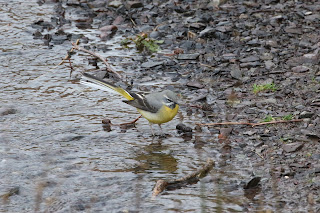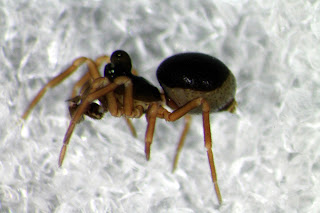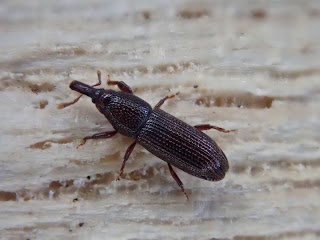Wednesday 2nd March 2022, Haughmond Hill
Our original planned trip to this site in February was
cancelled due to the anticipated arrival of Storm Dudley. So we tried again.
This time there was only a mild breeze but it was wet. Very wet.
However we had paid our parking dues so we were staying to try and get our money’s worth!
Slow progress was made towards the view point on top of the hill as we inspected various bits of vegetation on the way, usually with little found. But we persevered.
The rain got heavier.
What were we doing?
And then it started to ease, and by the time we reached the summit it had stopped.
It was still very grey and the view from the summit looked nothing like the toposcope suggested it should. But the toposcope provided an excellent spot for lunch.
Or was it?
By the time we had eaten we realised how cold the wind was.
We needed exercise to warm us up.
This was provided by a game of “Find the Shepherd’s Cress”. This is very much like “Hunt the needle in a Haystack” although we did have a positive outcome when some of this tiny plant was spotted.
 |
| Photograph: David Williams |
 |
| Photograph: David Williams |
Flushed with success we made ourway back to the car park with the occasional pause to see what we could find. One of these stops yielded a veritable feast as a slime-mould was found (as yet unidentified – these things take time);
 |
| Photograph: David Williams |
 |
| Photograph: David Williams |
And the colourful bug Corizus hyoscami in a flowering Gorse bush.
By the time we reached the cars the café had shut so there
was no choice but to make our way home to dry out.
Wednesday 9th March 2022, Carding Mill Valley
Is it Carding Mill or Cardingmill? The OS map shows it as Carding Mill, so that is what I will stick with.
Unfortunately I was unable to attend this outing so this report is based on a short report from Jim plus snippets from others.
On arrival we were greeted by full cloud and a breeze in the car park. After a chat with a Natuonal Trust chap we headed off, slowly! The vaccuum samplers were in regular use, sucking up the usual assortment of springtails, spiders and flies with a few beetles and weevils but very, very few bugs.
One of the flies found this way was a first record for Shrophire the tiny hybotid fly Stilpon graminum
 |
| Photograph: Nigel Jones |
We followed the path to the dam and as it came into view it got darker, the occasional spot of rain fell and the valley was funnelling the wind into us.
The final climb to the top of the dam was achieved. The wind was very strong but we were not deterred. We walked anticlockwise around the reservoir, vacuuming as we went.
Shelter was sought for lunch.
 |
| Photograph: Nigel Cane-Honeysett |
Amazingly there were swimmers in the dam. Perhaps it was warmer in the water!
After lunch the search continued before we called it a day and walked slowly back to the car park.
By the time we got near the cars it was still, no wind at all!
We returned home after a good day.
Here are some of the animals we found:
A pseudoscorpion, Neobisium carcinoides with its lunch:
 |
| Photograph: David Williams |
A weevil, Otiorhynchus singularis;
 |
| Photograph: Emm Cane-Honeysett |
The skull of a Crow;
 |
| Photograph: John Martin |
A bird that was very much alive, a Grey wagtail;
 |
| Photograph: John Martin |
A Bloody-nosed beetle;
 |
| Photograph: David Williams |
A spider that appears to have had a very nasty bump to its head, Pelecopsis mengei - this is a male, the female is not adorned in the same way;
 |
| Photograph: Nigel Cane-Honeysett |
A fly, Pollenia labialis;
 |
| Photograph: John Martin |
A Pine ladybird:
 |
| Photograph: John Martin |
Some Fountain apple-moss, Philonotis fontana;
 |
| Photograph: John Martin |
A weevil that we have not been able to identify, it is a Hypera species but it may be either nigrirostris or venusta;
 |
| Photograph: Emm Cane-Honeysett |
A group of lichenologists doing what they enjoy doing;
 |
| Photograph: Nigel Cane-Honeysett |
And another spider, Segestria senoculata.
 |
| Photograph: Nigel Cane-Honeysett |
Our arachnologist has provided the following snippet about this species:
This is “a tubeweb spider. Quite why they’ve decided to call these spiders tubeweb spiders I don’t know as they don’t make tube webs nor, indeed, any other kind of web. They live in “tubes” as much as they inhabit old beetle holes and holes in walls etc and they lay out trip lines from a collar around their hole which don’t ensnare their prey but just alert the spider to the presence of prey at which point the spider dashes out, grabs the prey and hauls it into its “tube”. Two other interesting things about the Segestriidae is that they have 6 eyes not the usual 8 and their front three pairs of legs point forward to assist dragging their prey into their lair.”
To finish the report of this visit. here is the distinctively shaped Wednesday Weevil of the Week Euophryum confine.
Wednesday 16th March, Wyre Forest
After two sunny days on the Monday and Tuesday the weather decided that this could not be sustained and it rained.
Undeterred we made our way to the site.
On the way the rain stopped.
There was even a patch of blue sky and a hint of sun.
But this was soon disappeared and grey cloud reasserted itself.
We arrived on site, got ready and set off.
And the rain started.
And continued …
And continued.
We stuck it out until lunchtime which was taken under some leaky conifers. Then for an hour or so more before we called it a day and splashed our way home to dry out.
The star find of the day was a small harvestman with a long name, Anelasmocephalus cambridgei, which sent our arachnologist into an state of ecstacy.
 |
| Photograph: David Williams |
The wet conditions made invertebrates difficult to find without the risk of drowning or damaging them and also made the photographers unwilling to get out their equipment out. However we did manage to capture and photograph the following:
A weevil, Strophosoma capitatum;
 |
| Paragraph: Emm Cane-Honeysett |
And its close relative, Strophosoma melanogrammum;
 |
| Photograph: Emm Cane-Honeysett |
An Ichneumon;
 |
| Photograph: David Williams |
And a suitably damp looking Pill millipede which, despite the weather, was content to walk about.
 |
| Photograph: Nigel Cane-Honeysett |
The final photograph for the report of this outing is the Wednesday Weevil of the Week, Kyklioacalles roboris, which is a scarce species.
 |
| Photograph: Emm Cane-Honeysett |
Wednesday 23rd March, Clee Liberty Common
After our drenching last week we were served up a day of glorious sunshine for our visit to Clee Liberty Common.
The Common is upland grassland on the slopes leading up to the peak of Clee Burf, which stands about 30 metres shorter than its near neighbour Abdon Burf.
The aim of the day was not to scale the heights but to look at the flora and fauna of the common. However the sight of the more accessible Nordy Bank hill fort as we entered the site was too much and we decided very early in the day that that would be a good spot for lunch.
The vast bulk of the common at this time of year is mostly a mixture of grass, gorse and dead bracken with a few overwintering hawthorns. It is grazed by sheep and, as a result, the sward is very short which severely limits the habitats available for invertebrates.
But, the views were spectacular.
 |
| Photograph: David Williams |
Nordy Bank hill fort is a large enclosure.
.jpg) |
| Photograph: Bob Kemp |
I did not measure its dimensions but “the internet” states that it is an oval about 260m, x 200m. There are several gaps in the ramparts some of which may be original with the others created later.
 |
| Photograph: David Williams |
The hill in the distance in the above photograph is Titterstone Clee.
The excellence of the scenery distracted our photographers from their usual subjects but fortunately our weevil aficionado remained on message.
Sitona striatellus;
 |
| Photograph: Emm Cane-Honeysett |
Rhinoncus castor;
 |
| Photograph: Emm Cane-Honeysett |
And the Wednesday Weevil of the Week, Tatianaerhynchites aequatus.
 |
| Photograph: Emm Cane-Honeysett |
And why, you may ask, is it the weevil of the week rather than the other two?
Because it is “because it’s so pretty (and hairy!)”.
We made our way back to the cars via the service track which took us past o row of trees with extensively exposed roots in exposed sandy soil. We were pleased to see that early solitary bees were making use of this resource.
The track led onto the road that took us back to the car park.
On the roadside verge opposite the parking area we found a collection of primroses flowering in the sun. These attracted not only our attention but that of some bumble bees and bee-flies.
Not only was the usual bee-fly, for this part of the country, Bombylius major seen:
 |
| Photograph: John Martin |
But also, to our surprise, Bombylius discolor, with its spotted wings and darker tip to its abdomen,
.JPG) |
| Photograph: John Martin |
The latter bee-fly has only arrived recently in the County and is one to keep an eye out for in future.
Wednesday 30th March 2022, Clun Castle
A week following our visit to Clee Liberty and the nearly 2000 year old fortification Nordy Bank we found ourselves in the grounds of the much more modern Clun Castle. The castle was founded in the 11th century following the Norman Conquest. It was neglected after the 14th century and was reported as ruined in the 16th.
 |
| Photograph: Bob Kemp |
The grounds of the castle are mainly ungrazed grassland, scrub, bushes and a few trees. The tree-lined River Clun runs along the edge of the grounds.
There was evidence of recent flooding as there was a lot of debris caught up in the lower branches of the riverside trees. This was investigated keenly to see if any animals, especially beetles, had been swept along with it.
Early finds were a couple of inconspicuous ladybirds:
Rhyzobius litura;
 |
| Photograph: David Williams |
And Nephus redtenbacheri.
 |
| Photograph: David Williams |
At the top of the mound, in the centre of the ruins, a patch of grass in a shallow hollow yielded three Small grass bugs of which two can be seen in the following photograph.
 |
| Photograph: David Williams |
Ants do not feature in these reports very often so here, for a change, are some Yellow meadow ants.
 |
| Photograph: Nigel Cane-Honeysett |
From the uplands of the mound on which the castle stands we descended to the grasslands by the river. Our Arachnologist seems excited by something in a tube.
 |
| Photograph: John Martin |
What caused him such joy?
A harvestman, Homalenotes quadridentata.
 |
| Photograph: David Williams |
There are old records of a couple of very rare umbellifers that have been found in the castle grounds. Here are the early signs of one of them, Knotted hedge-parsley.
 |
| Photograph: John Martin |
According to the Shropshire Flora this plant was once common as an agricultural weed.
Lunch was taken on a bank by the river during which we witnessed a boxing match between two female spides, Harpactea hombergi.
 |
| Photograph: David Williams |
A fly frequently seen at this time of year is Gymnocheta viridis. It has silver patches on its face and its body colour seems to vary between green and bronze.
 |
| Photograph: John Martin |
There was no sun and it was not very warm so it was a surprise that we found a Common lizard “basking” on a log. I think the lack of heat rendered it sluggish as it did not run away when we peered at it.
 |
| Photograph: John Martin |
The skies were getting greyer, adding an atmosphere of foreboding over the castle.
 |
| Photograph: Bob Kemp |
Remarkably the sky looks blue and cloudless in the above photograph and they say “the camera never lies”!
The sky was not blue, it was leaden …
And it started to rain.
Fortunately it was a passing shower so we continued on our merry way for a little while longer before returning to the cars when it started to rain in earnest.
Our Wednesday Weevil of the week is Squamapion cineraceum.
 |
| Photograph: Emm Cane-Honeysett |
My thanks to Forestry England, National Trust, West Midlands Buttrerfly Conservation, Foundation for Common Land, Clee St Margaret Parish Council and English Heritage for giving us permission to visit these sites. My appreciate as always to the photographers who continue to provide wonderful images for me to use.




























No comments:
Post a Comment
Please feel free to comment on this post...